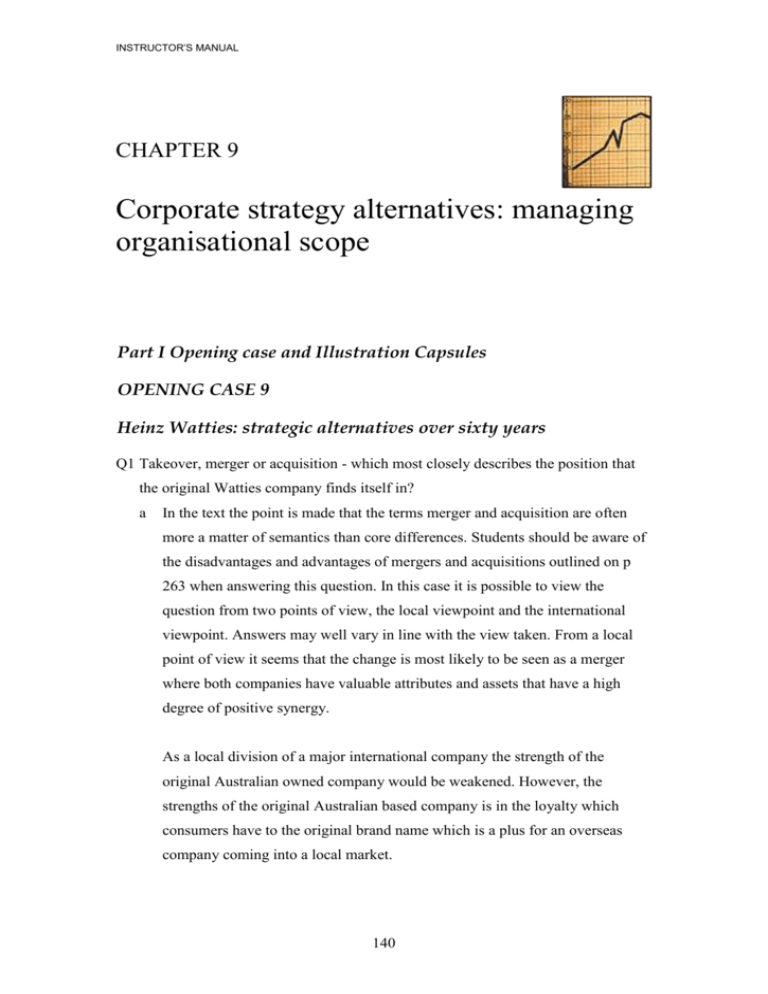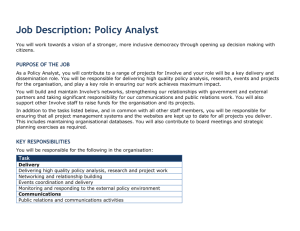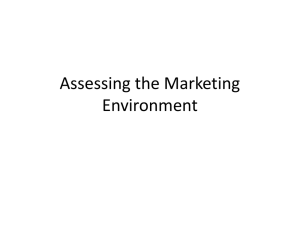Part IV True False Questions
advertisement

INSTRUCTOR’S MANUAL CHAPTER 9 Corporate strategy alternatives: managing organisational scope Part I Opening case and Illustration Capsules OPENING CASE 9 Heinz Watties: strategic alternatives over sixty years Q1 Takeover, merger or acquisition - which most closely describes the position that the original Watties company finds itself in? a In the text the point is made that the terms merger and acquisition are often more a matter of semantics than core differences. Students should be aware of the disadvantages and advantages of mergers and acquisitions outlined on p 263 when answering this question. In this case it is possible to view the question from two points of view, the local viewpoint and the international viewpoint. Answers may well vary in line with the view taken. From a local point of view it seems that the change is most likely to be seen as a merger where both companies have valuable attributes and assets that have a high degree of positive synergy. As a local division of a major international company the strength of the original Australian owned company would be weakened. However, the strengths of the original Australian based company is in the loyalty which consumers have to the original brand name which is a plus for an overseas company coming into a local market. 140 CHAPTER 9 - CORPORATE STRATEGY ALTERNATIVES: MANAGING ORGANISATIONAL SCOPE Q2 With Heinz and Watties combined, what is the value of this strategy to the Heinz corporation? a In making a decision to either takeover or merge with another company the Heinz US parent group effectively eliminated a strong competitor and allowed for the amalgamation of less profitable areas of both companies. The gains to Heinz appear to outweigh the costs of the merger in terms of a strong group of household name products. When two companies are working in the same area the profit is divided between the groups often depending on brand loyalty. Use of the newly developed centres of excellence has meant that Heinz have been able to retain the positives from acquiring the group without eliminating either the Wattie or Heinz brand and the potential consumers who were loyal to that brand. ILLUSTRATION CAPSULE 9.1 Divesting the Armed Forces 1 In light of world events on 11 September 2001 is this outsourcing strategy still appropriate? a This question should be looked at in terms of the importance of outsourcing as the question of the September 11 attack should not influence the decision of the armed forces in this matter. The attack itself was not based on military activity as such and cannot be considered a major factor. Had this not been terrorist activity but rather a standard strategic war effort then it would become a major influence. The method of determining the value of outsourcing to the military must be based on the financial factors and best use of resources that would previously have been taken into account when the decision was made. The job of highly trained military personnel is best suited to the core business of the service which in peace time is to develop appropriate skills which can be deployed as required. 141 INSTRUCTOR’S MANUAL 2 Organisations are advised to conduct a thorough analysis of the costs and benefits of all services they intend to outsource. Given that a number of large organisations have collapsed how important is this advice for organisations offering outsourcing services? a In any business situation the importance of determining both costs and benefits cannot be too highly emphasised. This becomes even more important in the relatively volatile environment that is in operation in this first decade of the 21st century. The collapse of major organisations has meant that those undertaking outsourcing for the companies or groups are in a very poor position themselves. The standard procedures that an organisation would take when dealing with a relatively unknown company are just as important when dealing with larger more established organisations. The methods of strategic management are applicable at all times but never more so than when operating in uncertain times. A consistent procedure for checking both external and internal environments will not necessarily ensure success but will at least guard against failure. ILLUSTRATION CAPSULE 9.2 Product modifications: leveraging the brand Q1 When there is an overlap between different commercial operations, as a result of licensing, as happened with the Harry Potter merchandise, how important is it for the originator of the character to maintain control? a A major consideration when using product extension strategies is that the new product retains the integrity of the original offering. Rowling's strength in retaining the character of Harry Potter and the standard and quality of endorsements from that product have proved to strengthen the over all product. In doing this both the author and the manufacturers of supporting materials and good have gained. Had she allowed major changes to be made to the original character, as was requested by the film makers, she may well have damaged both the future of the books and the products being produced. 142 CHAPTER 9 - CORPORATE STRATEGY ALTERNATIVES: MANAGING ORGANISATIONAL SCOPE The ‘brand’ of Harry Potter has retained its original character and the merchandising that has appeared to support it has leveraged off this strength. Consistency of the image and the merchandise may well have been sacrificed if the author had not taken such a strong stand. In doing so she has benefited all concerned. 2 When using popular children’s characters to promote product extension goods, are there any moral issues to consider? a There are ongoing ethical debates regarding the advertising and promotion of goods to children. So much so that most industrialised countries have legislation in respect to times and types of advertising that can be directed at children. The use of cartoon and literary characters to promote goods is one that comes under special scrutiny. It could be argued that in maintaining strict standards with regard to the merchandise associated with Harry Potter that Rowlings has taken a responsible role by ensuring that those goods meet an acceptable standard. Parents are confronted by demands for more and more goods associated with favourite characters from fiction, however, in this case the author has made the effort to ensure quality of product and consistency of character with the original offering. 143 INSTRUCTOR’S MANUAL ILLUSTRATION CAPSULE 9.3 BHP-Billiton merger Q1 In the changeover period for BHP and Billiton, from individual companies to a combined unit, how important was it to develop a change structure that included both CEOs? a In the BHP and Billiton merger there were many potential and foreseeable difficulties with both organisations having a different culture and the problem of having two CEOs and only one company. The operational decisions which were made regarding the deployment of these two men and the subsequent clarity of their roles gave the merger every chance for success. In cases where mergers take place there is frequently a great deal of bitterness and loss of identify from the group that perceive themselves as losing their corporate identity by being submerged in the new culture of the dominant organisation. The two CEOs of BHP and Billiton both had clear roles to play and both were able to move their own groups forward into the new amalgamated culture. In working cooperatively they are able, if not eliminate integration difficulties altogether, to at least minimize them. Q2 What were the reasons for Billiton and BHP joining forces? Were they both motivated by the same things? a Initially it would seem that there would be little synergy and ability to cooperate between the two companies who held quite diverse views on methods of operation. The time taken over the process of identifying each organisation’s strengths and weaknesses made it possible to see how the different approaches could not only be dealt with but also became a strength of the combined groups. The approach of the two organisations to globalisation is a major point with BHP preferring to move its business into new areas and Billiton preferring the merger approach. The strategic problems which are being encountered should not be minimised but the long term planning which took place before the 144 CHAPTER 9 - CORPORATE STRATEGY ALTERNATIVES: MANAGING ORGANISATIONAL SCOPE merger and continues with an unbroken chain of command after the change will ensure that this organisation has the best chance of succeeding in developing a cohesive company. Part II Discussion Questions 1. In the strategic management process, should strategy choice be conducted on an ongoing basis? Strategy choice refers to the process of generating, evaluating and choosing preferred strategies. Typically this process is not, and should not be, conducted on an ongoing basis except informally at the very highest levels of management. No organisation should put itself through the intensive questioning/assessment/analysis required of strategy choice (and the preceding strategy analysis) on a continuous basis. If it does, it will probably end up doing a poor job of the process. (i) Strategy choice should be performed at least once per year to coincide with the preparation of financial reports. This is an appropriate time to review the strategies which have led to current performance. (ii) Strategy choice should not only be conducted in times of poor performance. By the time this is recognised, it may be too late to do anything about it. (iii) In times of good performance, strategy choice cannot be ignored. Perhaps the organisation could have performed better. Perhaps there are unforeseen trends and developments which need to be acted upon now to ensure future strong performance. 145 INSTRUCTOR’S MANUAL 2. Most corporate level strategic options imply growth (through market penetration, product development, market development or diversification). Why is growth such a popular component of these strategies? Growth is the most common component of corporate level strategies for many reasons: (i) Growth equates with increased market share which results (often) in market power and improved performance. (ii) Managers in many organisations believe that growth is synonymous with success—it strokes their egos. (iii) Most industries grow over time, which means that unless organisations within the industry grow at the same rate at least, they are losing position in the market. As they become smaller less valued players, their relative performance falls. 3. Synergy is often stated as being important in the selection of a corporate level strategy. Is synergy necessary to ensure corporate success? Why? Why not? The answer here depends on the mission of the organisation. (i) If the mission is to conduct operations in terms of specified products, markets and technologies, then synergy is very important. It ensures that any new strategy is related to existing strategies and that there is some carryover of skills and resources. (ii) If the mission is simply to act as an investment company, then the only requirement of a new corporate strategy is financial performance— synergy is not considered. Each business is kept as long as it performs satisfactorily. This is often frustrating to the managers of each of these divisions because they can get little assistance (or understanding) from head office with regard to product, market, employee, technology, etc issues. Head office is only interested in ROI. Instructors may need to clarify the concept of synergy before discussing the above issues. 146 CHAPTER 9 - CORPORATE STRATEGY ALTERNATIVES: MANAGING ORGANISATIONAL SCOPE 4. What is the difference between a consolidation and a divestment strategy? In appearance these two strategies are very similar, but the strategic reason for their implementation differs. Consolidation is basically a short term strategy employed to restore balance to an organisation which is not performing well. It is usually a cost cutting exercise which begins with pruning costs across all organisational activities. Divestment is the disposal of entire units (products, product lines, divisions), usually because they do not fit the scope of the organisation. It is more a long term strategy in that whilst an organisation may resume activities ceased under a consolidation strategy, it will normally not reinvest in a divested function (at least not in the short to medium term). The Arnotts example in Illustration capsule 7.4 represents, in fact, a divestment strategy. 5. Although international strategies are necessary and are becoming more common for many organisations they also carry some risks. What sorts of problems give rise to these risks? The textbook does not concentrate on risks, but many exist. Investment—going international can require substantial investment funds, especially for manufacturing organisations. A lack of knowledge of the foreign environment can place these funds at risk. Culture—lack of appreciation of the intricacies and complexities of the foreign culture can cause difficulties in all aspects of operations, but especially in marketing and in the management of human resources. Regulations—at local, regional and national level are often not understood and can cause great difficulty with the relevant authorities. Language—operating in a foreign language is more problematic (locals can be employed to reduce the problem, but this strategy is resisted by organisations which want to keep the ethnic mix of management similar to that at international headquarters). 147 INSTRUCTOR’S MANUAL Control—despite modern communications, the issue of centralisation/decentralisation of authority is a complex one in international operations. What reporting system should be used? How can head office keep control of international operations without strangling initiative? Foreign exchange—the repatriation of profits can become a pointless exercise if exchange rates move strongly in the wrong direction. Staff—staff working in foreign countries are often under stress, from culture shock, perform below par and refuse to stay there long. 6. What do you think are the major disadvantages of growth through acquisition as opposed to internal development? The textbook focuses on the advantages of acquisitions, but disadvantages also exist: (i) An organisation may have to borrow heavily in order to acquire the right target company. This can place severe financial strain on the organisation through increased debt charges. (ii) Despite thorough investigations, an organisation can never be 100% sure of what it has acquired. Sometimes the acquired company is not all it was thought to be. (iii) Integrating the cultures of the two organisations after acquisition is often a difficult task eg. The Coles Myer 'merger'. Friction results and this reduces the performance of both organisations. 148 CHAPTER 9 - CORPORATE STRATEGY ALTERNATIVES: MANAGING ORGANISATIONAL SCOPE Part III Multiple Choice Questions 1. Which of the following statements is false? a. Corporate strategy must be developed for single-business firms b. Corporate strategy must be developed for multiple-business firms c. Business strategy must be developed for single-business firms d. Business strategy must be developed for each unit in the multiple-business firm e. 2. All are true When distributors are not performing adequately, the organisation should consider: 3. a. forward integration b. backward integration c. concentric diversification d. divestiture e. joint venture When the skills and resources of two or more organisations complement each other especially well, which of the following strategies could be most appropriate? 4. a. conglomerate diversification b. divestiture c. joint venture d. retrenchment e. integration The key difference between concentric and conglomerate diversification is that the former should be based on some commonality in: a. markets b. products c. technology d. all of these 149 INSTRUCTOR’S MANUAL 5. 6. 7. Qantas Airlines acquiring Glaxo Pharmaceuticals would be an example of: a. horizontal diversification b. joint venture c. conglomerate diversification d. concentric diversification e. market development Acquiring control over the retailers of your product is an example of: a. concentric diversification b. backward integration c. forward integration d. product development e. horizontal integration If an aluminium smelter acquired a coal powered electricity station, this would be an example of: 8. 9. a. forward integration b. backward integration c. horizontal integration d. concentric diversification e. market development When Mitre 10 opens a store in a new suburb, this is an example of: a. forward integration b. market development c. product development d. concentric diversification e. market penetration When Ford launches the latest Falcon onto the market, this is an example of: a. market penetration b. product development c. market development d. horizontal integration e. horizontal diversification 150 CHAPTER 9 - CORPORATE STRATEGY ALTERNATIVES: MANAGING ORGANISATIONAL SCOPE 10. If K Mart were to purchase a fleet of delivery vehicles to supply customers this would be an example of: 11. a. forward integration b. backward integration c. concentric diversification d. conglomerate diversification e. market penetration When differentiating a commodity type product will improve profitability, what type of strategy would be best? 12. a. forward integration b. backward integration c. horizontal integration d. market penetration e. joint venture In order to convert a cost centre into a profit centre what strategy would be best? 13. a. forward integration b. backward integration c. horizontal integration d. market penetration e. joint venture Concentric, conglomerate, and horizontal are terms that describe: a. development strategies b. marketing strategies c. diversification strategies d. retrenchment strategies e. none of the above 151 INSTRUCTOR’S MANUAL 14. An organisation that introduces existing products into new regional areas is using: a. product development strategy b. market development strategy c. market penetration strategy d. backward integration strategy e. diversification strategy 15. strategies involve reducing the scope of an organisation's operations. 16. 17. a. divestment b. growth c. intensive d. integrative e. diversification Which of the following is not one of the major levels of strategy? a. Corporate strategy b. Managerial strategy c. Business strategy d. Functional area strategy e. Operating strategy Functional or operational level strategies: a. indicate the kind of support which one business unit will give to another in a diversified company b. concern how to manage the major activities within a business unit c. help define what kind of competitive edge the business will strive to achieve d. are derived directly from corporate level plans e. concern how to compete successfully in each functional area of the business 152 CHAPTER 9 - CORPORATE STRATEGY ALTERNATIVES: MANAGING ORGANISATIONAL SCOPE 18. Which of the following is not a popular reason for pursuing an international strategy? a. The spread of international development is much more balanced than previously b. Technology has reduced the barrier of distance between countries c. International operations spread risk between different economies d. Many developing nations welcome international businesses in order to foster economic growth e. Managers with local expertise often seek international exposure to enhance their careers 19. 20. The major disadvantage of a merger or acquisition is: a. it enables rapid access to the target market b. it enables management to accurately predict the development costs involved c. it may reduce competition in a market d. it allows organisations to overcome market entry barriers e. none of the above are disadvantages of mergers or acquisitions An appropriate strategy for a market leader in the maturity phase of the product life cycle is: 21. a. reduce market share b. hold market share c. consider product extension strategies d. build market share e. c and d only An appropriate strategy for a market leader in the growth phase of the product life cycle is: a. reduce market share b. hold market share c. consider product extension strategies d. build market share e. withdraw from the market 153 INSTRUCTOR’S MANUAL 22. An appropriate strategy for a market leader in the decline phase of the product life cycle is: 23. a. reduce market share b. hold market share c. consider product extension strategies d. build market share e. withdraw from the market An appropriate strategy for a market follower in the growth phase of the product life cycle is: 24. a. hold market share b. withdraw from the market c. consider product extension strategies d. investment to increase market share e. none of the above An appropriate strategy for a market follower in the maturity phase of the product life cycle is: 25. a. develop a new competitive strategy b. hold market share c. consider product extension strategies d. investment to increase market share e. concentrate on a segment which can be dominated An appropriate strategy for a market follower in the decline phase of the product life cycle is: a. hold market share b. consider product extension strategies c. invest to increase market share d. concentrate of a segment which can be dominated e. withdraw from the market 154 CHAPTER 9 - CORPORATE STRATEGY ALTERNATIVES: MANAGING ORGANISATIONAL SCOPE 26. Market segmentation involves: a. identifying viable target markets which have distinct customer and competitor characteristics b. using different product distribution strategies for each market in the industry c. dividing the market into segments of approximately equal size in dollar terms d. attempting to create needs for a new type of product or service in an existing market e. 27. developing different markets at differential rates Which of the following is not acceptable as a method by which the financial feasibility of a new product idea can be assessed: a. break-even analysis b. payback period analysis c. estimation of return on investment d. test marketing e. all of the above are methods of assessing the financial feasibility of new product ideas 28. 29. Product extension strategies: a. are most appropriate in the maturity stage of the product life cycle b. are most appropriate in the growth stage of the product life cycle c. are most appropriate in the decline stage of the product life cycle d. are equally attractive at any stage of the product life cycle e. have no relation to product life cycles All of the following are examples of criteria which can be used to evaluate new product ideas, except: a. will the product give rise to synergy in production and marketing? b. will the product improve our company image? c. will the product improve our competitive advantage? d. will the product meet our cost, profit and volume requirements? e. can we access the raw materials and components necessary to produce this product? 155 INSTRUCTOR’S MANUAL 30. Which of the following is true of the process of financial analysis for new product ideas? a. If the product does not give rise to synergy in production and marketing, it should be dropped b. Forecasting expected sales revenue is more difficult than forecasting expected costs c. Financial analysis is the ultimate criterion by which a new product idea will be judged d. Break-even volume is the primary measure of the viability of a new product idea e. 31. All of the above A strategic alliance is: a. an agreement between superpowers to cooperate on a specified project b. an arrangement between different parts of a diversified organisation to target a specific market segment jointly c. an agreement between organisations to cooperate on a specified project d. an agreement between management and unions to cooperate on the implementation of a specified work system e. 32. all of the above are examples of strategic alliances Which of the following is not a typical stage in the new product development process? a. Test marketing b. Financial analysis c. Market segmentation d. Concept testing e. Idea generation 156 CHAPTER 9 - CORPORATE STRATEGY ALTERNATIVES: MANAGING ORGANISATIONAL SCOPE 33. 34. Synergy is: a. the degree of strategic fit between two activities b. when a team effort is used to achieve desired results c. when individuals work separately to achieve desired results d. when financial expectations of the organisations are decided upon e. the term used to describe effective diversified organisations Which of the following strategies is lowest in risk and in additional resources required? 35. a. Horizontal integration b. Innovation c. Market development d. Divestiture e. Concentration If a shirt manufacturer acquired a chain of men's clothing outlets, it would be an example of: 36. a. forward integration b. backward integration c. horizontal integration d. conglomerate diversification e. both a and d Which strategy makes an organisation most susceptible to performance variations resulting from industry trends? a. Concentration b. Vertical integration c. Horizontal integration d. Innovation e. Joint venture 157 INSTRUCTOR’S MANUAL 37. 38. Consolidation is typically accomplished through: a. asset reduction b. profit reduction c. cost reduction d. all of the above e only a and c When an organisation has excess production capacity and its basic industry is experiencing declining sales and profits, which of the following strategies could be most effective? 39. a. concentric diversification b. forward integration c. backward integration d. joint venture e. market development Organisations with a strong competitive position in an attractive market should pursue the following strategy: 40. a. unrelated diversification b. joint venture c. international strategy d. consolidation e. liquidation Subdividing a market into distinct subsets of customers according to their needs or behaviour is: a. market segmentation b. product diversification c. market segregation d. market development e. market positioning 158 CHAPTER 9 - CORPORATE STRATEGY ALTERNATIVES: MANAGING ORGANISATIONAL SCOPE 41. Which of the following is not a criterion by which the viability of a target market segment can be assessed? 42. 43. a. The segment must be measurable b. The segment must be substantial c. The segment must allow an organisation to use its distinctive competencies d. The segment must be large and flexible e. The segment must be accessible Two different market segments: a. can be merged using a product differentiation strategy b. usually require different marketing strategies c. are always in different geographic areas d. are usually competing with each other e. can usually be served with the same marketing strategy Which of the following is not a determinant of national competitive advantage: a. chance b. demand conditions c. size d. factor conditions e. related and supporting industries 159 INSTRUCTOR’S MANUAL Part IV True False Questions 1. Strategic gap analysis analyses the task facing the organisation in trying to reach its objectives 2. Strategic gap analysis is of little value in the public sector 3. Corporate strategy refers to the management of the entire organisation 4. Business level strategy refers to how an organisation implements its strategic decisions 5. Operational level strategy refers to how an organisation implements its strategic decisions 6. Business level strategy refers to the management of a discrete unit 7. Operational level strategy refers to the management of a discrete unit 8. Positive synergy occurs when commonality between business units can be exploited 9. Strategic alliances between competitors cannot occur 10. Without a profit motive strategy is of little value 11. Strategic management can be applied equally well to the public and private sector 12. A benefit of using market penetration strategies is improved performance core functions 13. Consolidation must be applied in good and bad times alike 14. Divestment strategy is not appropriate to public sector organisations 15. Test marketing in one state or city is referred to as a ‘roll-out’ launch 16. Product extension is most appropriate in the growth stage of the product life cycle 17. Vertical integration can be risky unless the field of economic activity is a very stable one 18. Market development is the process of developing new products in an established market 19. The international strategy is a specific form of market development 20. Principles of internationalisation vary between the public and private sector 160 CHAPTER 9 - CORPORATE STRATEGY ALTERNATIVES: MANAGING ORGANISATIONAL SCOPE Answers to Chapter 9 Multiple Choice Questions 1. e 2. a 3. c 4. d 5. c 6. c 7. b 8. b 9. b 10. a 11. a 12. b 13. c 14. b 15. a 16. b 17. b 18. e 19. e 20. e 21. d 22. a 23. d 24. b 25. e 26. a 27. d 28. a 29. d 30. b 31. c 32. c 33. a 34. e 35. a 36. a 37. e 38. a 39. d 40. a 41. d 42. b 43. c True False Questions 1. T 2. F 3. T 4. F 5. T 6. T 7. F 8. T 9. F 10. F 11. T 12. T 13. T 14. F 15. T 16. F 17. T 18. F 19. T 20. F 161








